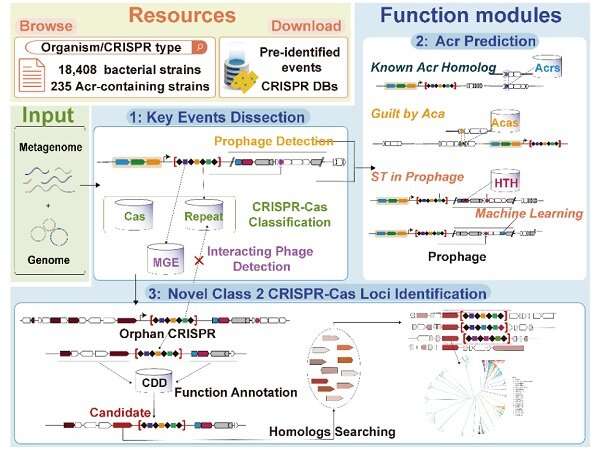This article has been reviewed according to Science X's editorial process and policies. Editors have highlighted the following attributes while ensuring the content's credibility:
fact-checked
peer-reviewed publication
trusted source
proofread
Team develops CRISPR tool with big data visualization platform for genome editing and modification

A research team from the Hefei Institutes of Physical Science of the Chinese Academy of Sciences (CAS) has developed an analysis service platform called CRISPRimmunity, which was an interactive web server for identifying important molecular events related to CRISPR and regulators of genome editing systems. The study is published in Nucleic Acids Research.
The new CRISPRimmunity platform was designed for integrated analysis and prediction of CRISPR-Cas and anti-CRISPR systems. It includes customized databases with annotations for known anti-CRISPR proteins, anti-CRISPR-associated proteins, class II CRISPR-Cas systems, CRISPR array types, HTH structural domains and mobile genetic elements. These resources allow the study of molecular events in the co-evolution of CRISPR-Cas and anti-CRISPR systems.
To improve prediction accuracy, the researchers used strategies such as homology analysis, association analysis and self-targeting in prophage regions to predict anti-CRISPR proteins. When tested on data from 99 experimentally validated Acrs and 676 non-Acrs, CRISPRimmunity achieved an accuracy of 0.997 for anti-CRISPR protein prediction.
In addition, the platform provided the first ab initio prediction algorithm for class II CRISPR-Cas systems, identifying several previously unknown proteins. These included four Cas9s with different PAM structural domains, a smaller Cpf1, 61 C2c10s and three unclassified novel V-type Cas proteins. Some of these proteins had already been experimentally validated for in vitro activity.
CRISPRimmunity has many advantages, according to the team. It is an easy-to-use web server that provides a comprehensive analysis platform for CRISPR-related research. It accurately predicts anti-CRISPR proteins and identifies novel class II CRISPR-Cas loci, providing an evolutionary perspective of the CRISPR-Cas and anti-CRISPR systems. Unlike other resources that focus on specific domains only, CRISPRimmunity fills the gap by providing methods to identify novel class II CRISPR-Cas systems.
The user-friendly interface offers various visualization and customization options, with machine-readable results and tutorials for users of all levels. The NCBI database provides access to annotated data on 18,408 fully sequenced and 235 Acr-containing bacteria, and 208,209 human gut microorganisms, including information on key CRISPR-associated molecular events.
Users can download or view this data to aid future experimental design and data analysis. Also for computational biologists, a stand-alone version of CRISPRimmunity is available on Github for bulk data mining.
More information: Fengxia Zhou et al, CRISPRimmunity: an interactive web server for CRISPR-associated Important Molecular events and Modulators Used in geNome edIting Tool identifYing, Nucleic Acids Research (2023). DOI: 10.1093/nar/gkad425
Platform: www.microbiome-bigdata.com/CRISPRimmunity/index/
Source code for batch analysis: github.com/HIT-ImmunologyLab/CRISPRimmunity
Journal information: Nucleic Acids Research
Provided by Chinese Academy of Sciences





















